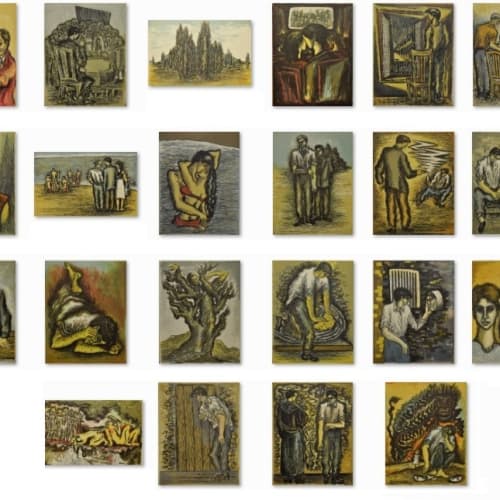During this year's Asian Art in London, Grosvenor Gallery will be exhibiting works by the Pakistani painter Syed Sadequain (1930-1987). Sadequain in Paris will run from the 5 - 14 November 2015, with a late night opening at the gallery on Sunday 8 November.
Sadequain is regarded as one of the most important South Asian artists of the 20th century, and received widespread critical acclaim during his lifetime. The works on display were produced during the artist's years in Paris (1961-1967), widely considered to be the peak of his career as an artist.
Before he came to Europe Sadequain was a successful artist in Pakistan, and had already completed a number of municipal murals in Karachi and Lahore. Sadequain travelled to Paris in 1960 at the invitation of the International Association of Plastic arts. In 1961 he was the laureate winner at the 2nd Paris Biennale and was awarded a scholarship which allowed him to stay in Paris. The following years were some of the most important for Sadequain in terms of his artistic development, and he exhibited extensively in France, as well as in the USA and UK. He was well received by Parisian artistic society and in 1964 was directly compared to Picasso by the French media.
One of the most significant events of his career in Paris was the awarding of the commission to illustrate a new edition of Albert Camus' novel L'Étranger (The Stranger/The Outsider), one of the most important French novels of the 20th century. He produced 22 colour lithographs illustrating the story of Meursault, an ill-fated Algerian who is imprisoned after shooting a man on a beach. Grosvenor Gallery will be exhibiting the entire suite of lithographs, as well as a rare original works and preparatory sketches for the series.
Other works on display will include a number of the original drawings for the 1966 book Sadequain, Sketches and Drawings, Editions Mystique. These important works from a private Parisian collection are beautifully detailed and are one of the artistic highlights of Sadequain's time in Paris. They feature characteristic subjects such as self-portraits, cacti, nesting crows, heads, crucified figures and men trapped in web like structures. The book was published with a forward by Faiz Ahmad Faiz, in which he comments; "The most obvious feature of the work displayed in this book, however, is Sadequain's virtuosity in whatever medium he operated and his varied and eclectic idiom based on a wealth of sources, from medieval calligraphy to modern posters, from classical sculpture to modern expressionism."
These will be shown alongside large scale oil paintings from late on in Sadequain's 'Paris period', which are much more expressionist than his earlier works, and which are thought to have been created for an exhibition in Rouen in 1967, alas never held due to the artist's return to Pakistan that year. The paintings depict characteristic Parisian scenes in a palette of greys, blues and burnt ochres, influenced by the work of École de Paris artists such as Pierre Soulages, Serge Poliakoff, Jean-Michel Atlan. Sadequain's paintings mark a departure to a more fluid and abstract style and show the artistic development of the artist over the years.
SADEQUAIN IN PARIS will be an extremely rare opportunity to see such a body of work by one of the most important modern Pakistani artists. A limited edition catalogue will be available to purchase during the exhibition, which continues until the 14 November.



